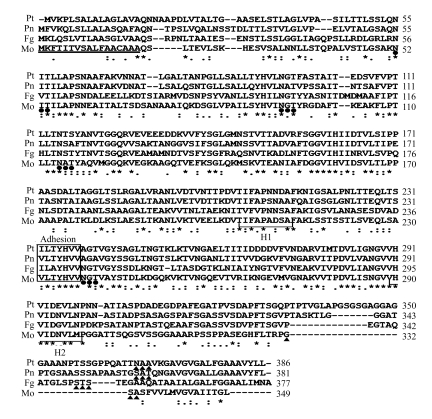Fig. 1.
Alignment of the predicted MoFLP1 protein sequence with fungal homologues
The sequences are MoFLP1 of M. oryzae (Mo, GenBank accession No. FJ608586), homologues of Pyrenophora tritici-repentis (Pt, GenBank accession No. XP_001942181), Phaeosphaeria nodorum (Pn, GenBank accession No. XP_001798270), and Fusarium graminearum (Fg, GenBank accession No. XP_382301). Sequences were aligned with ClustalW program and manually edited. The number of amino acids of each protein is given at the right of the alignment. Identical residues in all sequences are indicated by asterisks. Dashes indicate the gaps in all sequences. Dots and colons indicate semiconserved and conservative substitutions in all sequences, respectively. The conserved regions characteristic of fasciclin domains, H1 and H2, are indicated below the alignment and amino acids that are thought to be involved in adhesion are boxed and indicated above the alignment. The sequence in the N-terminus indicating a predicted signal peptide is underlined. The conserved potential N-glycosylation sites (NIT, NGT, NAT, and NGT) are underlined by black circles and the attachment/cleavage sites in the putative GPI anchor additional sequence are indicated by black triangles

